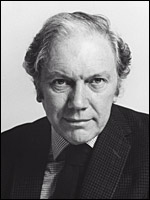Michael Relph facts for kids
Quick facts for kids
Michael Relph
|
|
|---|---|
 |
|
| Born |
Michael Leighton George Relph
16 February 1915 Broadstone, Dorset, England
|
| Died | 30 September 2004 (aged 89) Selsey, West Sussex, England
|
| Nationality | English |
| Occupation |
|
Michael Leighton George Relph (born February 16, 1915 – died September 30, 2004) was a talented English filmmaker. He worked as a film producer, art director, screenwriter, and film director. His father, George Relph, was also a famous actor.
Contents
Starting in Film: Art Direction
Michael Relph began his career in movies in 1933. He started as an assistant art director at Gaumont British studios. An art director helps design the look of a film. This includes the sets, costumes, and overall visual style.
In 1942, Relph joined Ealing Studios, a very famous British film studio. There, he became the chief art director. One of his most notable works was the spooky film Dead of Night (1945). His designs helped create the creepy atmosphere of the movie.
He often worked with director Basil Dearden. In 1949, Relph was even nominated for an Academy Award (an Oscar!) for his art direction. This was for his work on the historical film Saraband for Dead Lovers (1948).
Becoming a Film Producer
Michael Relph is best known for being a film producer. A producer helps manage the making of a film. This includes finding money, hiring the crew, and overseeing the whole project.
He was an associate producer for the classic Ealing comedy Kind Hearts and Coronets (1949). This film is still loved today.
Relph had a very important partnership with director Basil Dearden that lasted 20 years. They worked together on many films from 1949 until Dearden's death in 1971.
Films About Important Issues
Relph and Dearden made a series of films that explored important social issues. These movies were sometimes called "social problem films." They aimed to make people think about real-world challenges.
For example, they made films about:
- Racism: Pool of London and Sapphire looked at racial prejudice.
- Young People and Crime: Violent Playground explored issues with juvenile delinquency.
- Treating Everyone Fairly: Victim discussed fairness and understanding for all people.
- Religious Differences: Life for Ruth dealt with religious intolerance.
Relph believed that movies could teach people. He felt that films had a responsibility to educate and make a positive impact. The New York Times newspaper praised Life For Ruth. They said it was "dramatic, powerful and provocative."
Later Career and Influence
After his partnership with Dearden, Michael Relph continued to be involved in the film industry. From 1972 to 1979, he was the chairman of the British Film Institute's Production Board. This role meant he helped decide which films would get made.
He also led the Film Production Association of Great Britain. Later, in the 1980s, he worked for Boyd's Company. There, he helped new and exciting directors get their start. These included Derek Jarman (who made The Tempest) and Julien Temple (who directed The Great Rock 'n' Roll Swindle).
His Family in Film
Michael Relph's family also followed him into the film world. His son, Simon Relph, became a film producer too. Simon was even the chairman of BAFTA, a major British film organization.
His daughter, Emma Relph, worked as an actress in the 1980s. She appeared in several TV shows and movies. His stepson, Mark Law, became a journalist and author.
Selected Films Michael Relph Worked On
- They Drive by Night (1938) (art director)
- Went the Day Well? (1942) (assistant art director)
- The Bells Go Down (1943) (art director)
- My Learned Friend (1943) (art director)
- Champagne Charlie (1944) (art director)
- The Halfway House (1944) (art director)
- They Came to a City (1944) (art director)
- Dead of Night (1945) (art director)
- The Captive Heart (1946) (producer, art director)
- The Life and Adventures of Nicholas Nickleby (1947) (art director)
- Frieda (1947) (producer, production designer)
- Saraband for Dead Lovers (1948) (producer, production designer)
- Kind Hearts and Coronets (1949) (producer)
- Train of Events (1949) (producer)
- The Blue Lamp (1950) (producer)
- Cage of Gold (1950) (producer, production designer)
- Pool of London (1951) (producer)
- I Believe in You (1952) (director, producer, screenplay)
- The Gentle Gunman (1952) (producer)
- The Square Ring (1953) (producer)
- The Rainbow Jacket (1954) (producer)
- Out of the Clouds (1955) (producer, screenplay)
- The Ship That Died of Shame (1955) (producer, screenplay)
- Who Done It? (1956) (producer)
- The Smallest Show on Earth (1957) (producer)
- Rockets Galore! (1957) (director)
- Davy (1957) (director)
- Violent Playground (1958) (producer)
- Desert Mice (1959) (director, producer)
- Sapphire (1959) (producer)
- The League Of Gentlemen (1960) (producer)
- Man in the Moon (1960) (producer, screenplay)
- Victim (1961) (producer)
- The Secret Partner (1961) (producer)
- All Night Long (1961) (producer, production designer)
- Life for Ruth (1962) (producer)
- A Place to Go (1963) (producer, screenplay)
- The Mind Benders (1963) (producer)
- Woman of Straw (1964) (producer, screenplay)
- Masquerade (1965) (producer, screenplay)
- The Assassination Bureau (1968) (producer, screenplay, production designer)
- The Man Who Haunted Himself (1970) (producer, screenplay)
- Scum (1979) (producer)
- An Unsuitable Job for a Woman (1982) (producer)
- Heavenly Pursuits (1986) (producer)
- Torrents of Spring (1989) (production consultant)

